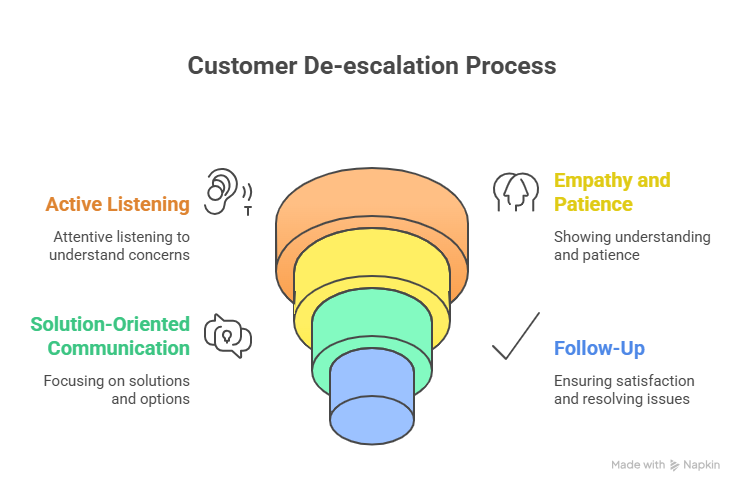Effective De-Escalation Techniques for Customer Service Success
19 Nov 2024 By: Maria Rush
Updated
Understanding the Importance of De-Escalation in Customer Service
De-escalation plays a key role in customer service, easing tension during conflicts. When customers feel valued and heard, they tend to remain loyal.
Effective de-escalation techniques not only resolve issues but also build trust. Emotional connections boost lifetime value and spark word-of-mouth, driving business growth.

The Role of De-Escalation Techniques in Customer Retention
Customer retention depends heavily on how conflicts are managed. When customers feel respected, they are more likely to stay. Effectively de-escalating conflicts can create a lasting positive impression.
Skillful complaint handling keeps clients satisfied. Satisfied customers return and refer others, boosting brand reputation. Studies reveal that resolving a complaint in a customer’s favor can build stronger loyalty than if no problem arose at all. This underscores the importance of treating conflicts as chances to deepen relationships and showcase dedication to customer satisfaction.
How De-Escalation Techniques Enhances Customer Experience
A positive customer experience drives business success, and de-escalation plays a vital role. When issues arise, a calm, thoughtful response makes a big difference.
Customers seek solutions and empathy. Addressing concerns quickly and kindly creates memorable moments. This not only resolves frustrations but builds lasting loyalty. Training staff in de-escalation techniques equips them to handle tough situations with confidence, improving workplace morale. Confident employees approach customers with positivity, fostering a cycle of great service and strong loyalty.
De-Escalation Techniques and Strategies
De-escalation techniques demands skill, blending art and science. Specific techniques can effectively soothe frustrated customers and restore calm.
Successful strategies emphasize clear communication and empathy. With the right tools, representatives can ease tensions and encourage cooperation.

Active Listening: The First Step in De-Escalation
Active listening is essential. It requires giving the customer undivided attention, helping agents understand concerns fully and respond effectively.
This approach conveys respect. When customers feel heard, they relax and share concerns openly. Paraphrasing their words confirms understanding, reassures them, and clarifies any confusion. Reflecting their concerns shows genuine engagement, reducing frustration and fostering productive dialogue.
Empathy and Patience: The Human Touch in De-Escalation
Empathy is understanding another’s emotions, creating a connection with the customer. Adding patience strengthens this bond even more.
When agents show empathy and stay patient, tensions ease. Customers value kindness during stressful times, leading to better interactions.
Using empathetic phrases like “I see why this feels frustrating” or “I understand your concerns” validates feelings and fosters collaboration. This humanizes the conversation and encourages open dialogue. Patience allows customers to vent without interruption, showing their emotions are respected and valued, paving the way for resolution.
Solution-Oriented Communication: The Path to Resolution
Clear communication drives effective solutions. Using solution-focused language steers conversations toward positive results. Customers want to see progress and resolution.
Highlight what can be done, not what can’t. This approach builds trust and assures customers their problems can be solved. Offering options empowers customers, involving them in decisions and showing their input matters. This collaboration resolves issues and strengthens the customer-brand relationship, fostering loyalty.
Following up after resolving an issue reinforces care and ensures no concerns remain. This commitment to customer satisfaction leaves a lasting impression.
Implementing De-Escalation Training in Your Organization
Training staff in de-escalation is vital and benefits organizations significantly. Investing in these skills directly enhances customer interactions.
Regular training keeps teams ready. Each session sharpens conflict resolution abilities, boosting confidence in tough situations. This confidence improves performance and creates a supportive workplace where employees feel empowered to face challenges. As they apply these techniques, they deepen emotional intelligence, a key factor in managing complex interactions effectively.
Identifying the Need for De-Escalation Techniques Training
Recognizing the need for training is essential. Review customer feedback and complaint data to spot recurring issues that signal gaps in skills.
Low customer satisfaction is a call to act. Assess team abilities and identify areas for growth. Anonymous employee surveys can also reveal hidden challenges. These insights provide a fuller picture of training needs, ensuring your approach addresses both visible and underlying issues effectively.
Designing an Effective De-Escalation Training Program
Tailor training programs to fit team needs. Role-playing real scenarios helps employees practice, making sessions practical and relatable.
Use engaging materials like videos, case studies, and discussions to boost participation and retention. Guest speakers or conflict resolution experts can add valuable insights and perspectives. Create a safe environment for employees to share thoughts and ask questions, fostering continuous learning and growth.
Measuring the Impact of De-Escalation Techniques Training
After training, evaluate its impact on customer interactions. Track metrics like satisfaction scores and resolution rates to gauge effectiveness.
Staff feedback is equally important. Employees can share experiences, offering insights to refine future training. Follow-up sessions or refreshers reinforce skills and keep them sharp. Continuous evaluation ensures training stays relevant, meeting the changing needs of employees and customers. Encouraging ongoing discussions about de-escalation fosters a culture of effective communication and conflict resolution throughout the organization.
Navigating Difficult Customer Interactions: A De-Escalation Guide

Handling tough interactions is a key part of de escalation techniques for customer service. A well-trained team can navigate challenges confidently, using a clear guide to simplify the process.
Recognize patterns in escalated situations. Spotting triggers allows agents to anticipate issues and manage emotions, keeping interactions under control.
Recognizing the Signs of Escalating Tension
Customer emotions can escalate fast. Look for signs like raised voices or tense body language. Recognizing these cues helps agents respond quickly and effectively.
Staying alert to frustration allows timely de-escalation. Address tension immediately. Understanding context, like long wait times or repeated issues, helps agents tailor empathetic, thoughtful responses.
Applying De-Escalation Techniques in Real-Time Scenarios
Applying learned techniques in real interactions is crucial. Encourage agents to stay calm, even with upset customers. Calm behavior can naturally soothe tension.
Use phrases that defuse anger, like “I understand your concern,” to steer focus toward solutions. Active listening, such as paraphrasing concerns, shows genuine engagement. This validates feelings and fosters collaboration, paving the way for effective resolutions.
Maintaining Professionalism in High-Stress Situations
Professionalism is crucial, especially under stress. Maintain a calm tone and respectful language to show control and confidence in handling the situation.
Staying composed helps customers reflect this behavior, leading to productive conversations and quicker resolutions. A clear escalation process empowers agents and reassures customers their concerns will be handled properly. Regular training in professionalism and stress management builds resilience and equips teams to navigate challenging interactions with grace and effectiveness.
Frequently Asked Questions
Trending Now
Generative AI (GenAI) is set to transform customer service by resolving common challenges like impersonal interactions, delays, and repetitive tasks. It turns frustrations into meaningful engagement opportunities.
By analyzing large datasets and learning from past interactions, GenAI delivers personalized, empathetic responses. It streamlines communication and boosts satisfaction for both B2B and B2C customers. Applications include real-time inventory updates, tailored pricing, personalized marketing, and efficient sales support. This ensures faster, more customized, and ever-improving customer experiences.
Ready to ensure your customer interactions are always calm and productive? With HelpSquad BPO, you gain access to a dedicated team of virtual assistants and 24/7 customer service professionals who are skilled in the art of de-escalation techniques. Starting at just $8.50 per hour, our bilingual agents are equipped to boost your brand’s efficiency and help maintain the highest standards of customer satisfaction. Don’t miss the opportunity to transform your customer service experience. Start your trial today and witness the difference HelpSquad can make!


